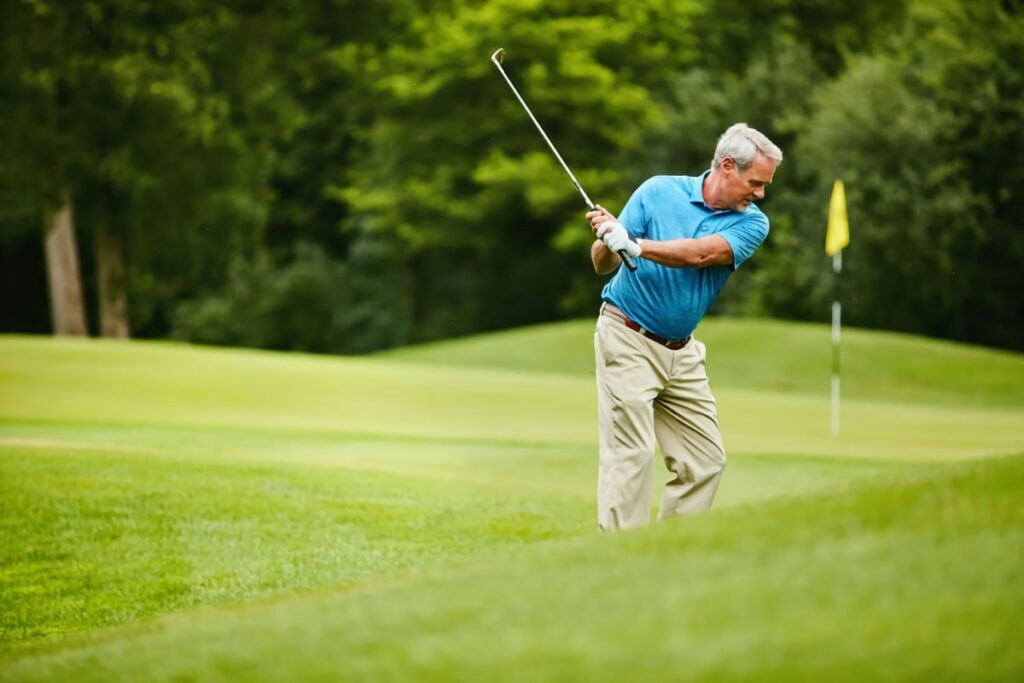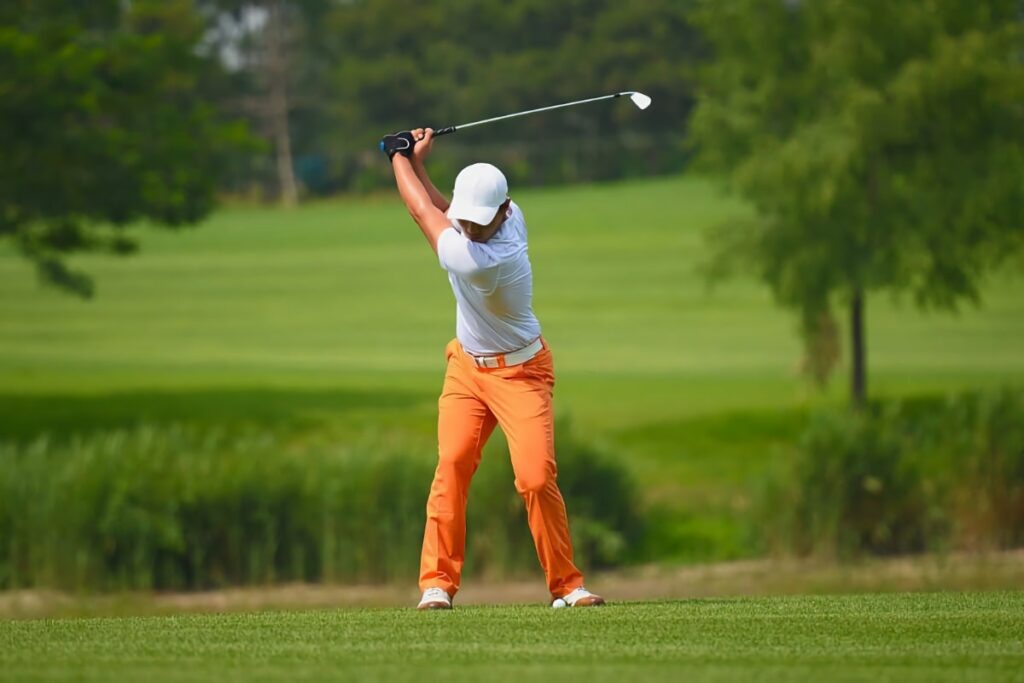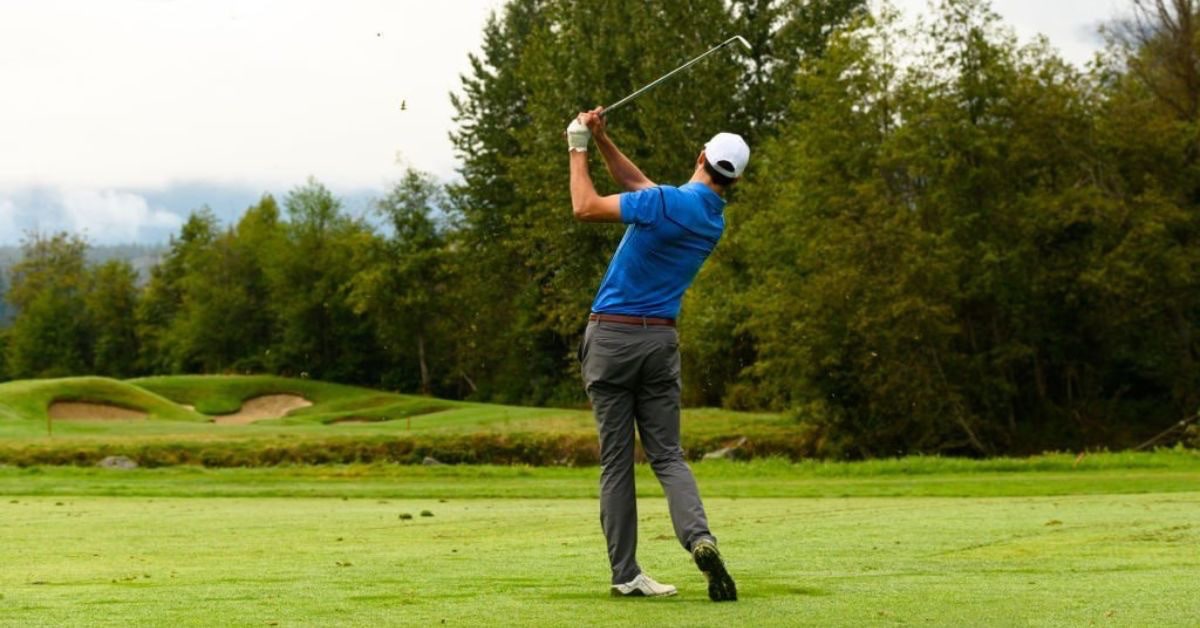Since you’re here, you’re probably wondering if there’s any difference between a wedge swing and an iron swing. After all, they have different lofts, lengths, and weights.
In short, the swing techniques are very similar — but there are slight differences.
In this article, you’ll learn the differences between the wedge swing vs the iron swing.
I’ll cover everything you need to know — from setup to swing — to help you understand how to hit better shots with your wedges and irons on the course.
Wedge Swing vs Iron Swing
The difference between a wedge swing vs iron swing is the power and length of the swing. With wedges, swing at a maximum of 80% power, with hands level with your shoulders in the backswing for better swing control. With irons, swing at 90% with higher hands for full extension.
Essentially, you want as much accuracy as possible from a closer range. Hence, the wedge swing should be relatively slower and more controlled than the iron swing.
Here are the key differences between wedges and irons — from setup to swing:
| Wedges | Irons | |
| Ball Position | Slightly back in the stance | Slightly forward in the stance |
| Forward Press | Slight forward press | Slight forward press |
| Swing Power | Maximum 80% power | Always around 90% power |
| Swing Length | Hands level with shoulders | Hands higher than shoulders |
The Wedge Swing

With wedges, your aim is often to pitch the ball as close to the pin as possible.
For the wedge swing, you want to swing with control. Put simply, this means a three-quarter swing that gives you the best chance of making good contact with the ball.
3 main areas differentiate the wedge swing from the iron swing:
- Ball position slightly back in your stance
- Slight forward press in your hands at address
- Maximum of 80% power in full swings
Let’s cover each area in some more detail!
1. Ball Just Back in the Stance
For wedges, position the ball slightly back in your stance.
Stand with your feet together and the ball in the middle of your stance. Then, take a small step with your left foot, and a slightly smaller step with your right foot.
Essentially, this will position the ball about “half a ball” back of center, encouraging you to strike down on the ball for the best possible strike.
If you set up with the ball too far forward in your stance, it exposes the leading edge of the higher-lofted wedges — risking thin or fat shots.
2. Slight Forward Press in the Hands
Push your hands just forwards of your belt buckle, adding a slight forward press.
With a slight forward press, the clubface naturally sits open just a touch at address. In effect, this makes it easier to make consistent contact compared to a closed face.
Although, don’t press too far forward. Too much forward shaft lean at address will deloft the club, resulting in inflated distances and inconsistencies.
3. Take Full Swings at 80% Power
With the wedge swing, take full swings at a maximum of 80% power.
Wedge shots are all about control, rather than distance. It’s better to swing within your means and focus on strike, as opposed to hitting the ball long of the green.
In the backswing, make a full turn but don’t extend your hands above shoulder height.
Then, swing comfortably through the ball and finish with your hands to the left of your face, rather than around the back of your head as with longer clubs.
Essentially, a shorter swing helps facilitate control, while limiting the possibility of any swing flaws adding a level of inconsistency to the strike.
PRO TIP: While the wedge swing varies depending on distance into the green, it should always feel like less effort than a full iron swing.
The Iron Swing

The iron swing differs largely due to the lower degree of loft and longer shaft length.
For the iron swing, you want to swing with slightly more speed. This means closer to 90% power, giving you the best chance of maximizing distance with each club.
Here are 3 key setup and swing components for the iron swing:
- Ball position slightly forward in your stance
- Slight forward press in your hands at address
- Maximum of 90% power in full swings
Once again, let’s cover each of these below.
1. Ball Just Forward in the Stance
For mid to long irons, position the ball slightly forward in your stance.
Stand with your feet together and the ball in the middle of your stance. Then, take a medium step with your left foot, and a slightly larger step with your right foot.
In effect, this will position the ball about “half a ball” forward of center.
This is optimal for striking irons, as you want to shift weight onto your front foot in the downswing. At the point of contact, you’ll be able to compress the ball effectively.
Conversely, if you have the ball too far back in your stance with irons, your swing will be too steep into the ball. This results in high, spinny, and loss of distance.
2. Slight Forward Press in the Hands
Push your hands just forwards of your belt buckle, adding a slight forward press.
This step is similar to the wedge swing. Once again, a slight forward press will open the clubface just a touch, making it easier to make consistent contact.
However, don’t press too far forward as this will effectively deloft the club.
3. Take Full Swings at 90% Power
With the iron swing, take full swings at around 90% power.
In the backswing, take the club back as far as you comfortably can to maximize the power in the swing through the coil effect, before returning to the downswing.
Then, keep your head over the ball at the point of impact, and swing through the ball with complete follow-through — finishing with your hands behind your head.
PRO TIP: Don’t exceed 90% power to ensure you remain balanced in the swing, promoting better contact with the ball.
In the video below, Matt Fischer of MrShortGame outlines the key differences between the wedge swing and the iron swing:
Final Thoughts
In summary, the main differences between the wedge swing and the iron swing are the amount of power you use, and the length of the swing.
With wedges, swing at a maximum of 80% power. While you should have a full turn in the backswing and follow-through, the hands shouldn’t lift above the shoulders.
With irons, swing closer to 90% power. This involves making a full rotation, raising the hands above the shoulder line in both the backswing and the follow-through.
Ultimately, every golfer has a different swing. But, if you apply these swing thoughts to your game, you can improve your ball striking with your wedges and irons.


